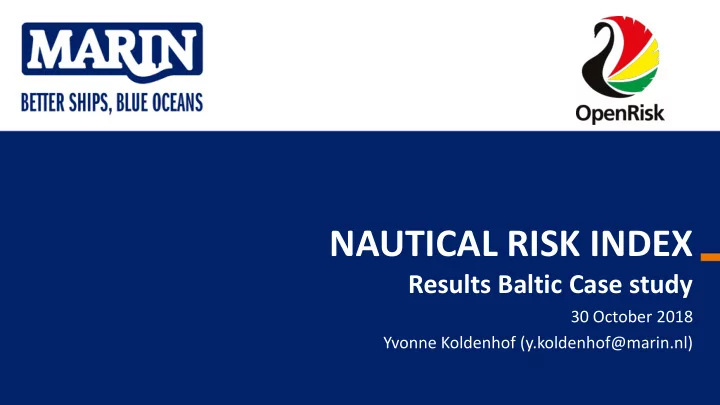

NAUTICAL RISK INDEX Results Baltic Case study 30 October 2018 Yvonne Koldenhof (y.koldenhof@marin.nl)
DEVELOPMENT NAUTICAL RISK INDEX Start: SAMSON: Safety Assessment Model for Shipping and Offshore on the North sea (can also be used on other places….) Important part of safety assessment model is the traffic database/model SAMSON route network consisting of waypoint and links with lateral distribution and shipping intensity First based on experts and traffic databases from e.g. Lloyds Later – now this database can also be built up using AIS-data Introduction AIS analysis of the data like density charts, shipping intensities and encounters (near- misses) Combine safety assessment model and AIS-data Nautical Risk Index 2
NAUTICAL RISK INDEX; DEFINITION Risk index: calculated value for each individual ship indicating the average risk of the ship at that moment. Risk = Probability * Consequences Probability expected probability of an accident when a ship will be present at the given location (AIS) taking into account different given factors; Consequences expected consequences given an accident (in this case the expect amount of oil (or chemical) spill); 3
GENERAL IDEA NAUTICAL RISK INDEX (SAMSON) Area layout & Navigational aids & Accident statistics; measures Lloyd’s accident traffic intensity; ( pilot, tug, VTS, etc. ) database 1990 - 2015 Accident frequency models Number of exposures (possible dangerous situations) Number of expected accidents 4 4
RISK INDEX: FREQUENCY MODEL • EXP : Exposure for a certain accident type (i), e.g. encounter • CASRAT : Casualty (accident) rate for a certain accident type (i) for a certain type of ship and ship size P accident ( i ) = EXP( i ) * CASRAT( i, type, size ) • F flag = multiplication factor for flag state (Port State Control List) • F age = multiplication factor for age of the ship • F wind = multiplication factor for wind • F vis = multiplication factor for visibility • F nav = multiplication factor for navigational status P accident ( i ) = F flag * F age * F wind * F vis * F nav * EXP( i ) * CASRAT( i, type, size ) 5
STUDY AREA 6
DENSITY MAPS 7
TRACKS 8
PROCESS BALTIC CASE STUDY: GROUNDING LINES KAART VERVANGEN 9
GRID-SIZE 10x10km 2x2km 5x5km 10
GULF OF FINLAND – SHIP-SHIP COLLISION St. Petersburg Helsinki Tallinn 11
GULF OF FINLAND – SHIP-SHIP COLLISION Ferry / Passenger Tanker 12
GULF OF FINLAND – COMPARISON WITH REAL ACCIDENTS St. Petersburg Helsinki Tallinn 13
GULF OF FINLAND – DRIFTING FREQUENCIES St. Petersburg Helsinki Tallinn 14
SOUTH-WEST PART – SHIP-SHIP COLLISION Gotland Klaipeda Malmo Gdynia Gdansk Rostock 15
SOUTH-WEST AREA – SHIP-SHIP COLLISION Ferry / Tanker Passenger 16
SOUTH-WEST AREA – COMPARISON WITH ACCIDENTS Gotland Klaipeda Malmo Gdynia Gdansk Rostock 17
FOLLOW THE TRACK OF A VESSEL Collision frequency 18
CONCLUSIONS • The Nautical Risk Index can be used in the Baltic Sea area • An approach using AIS and a “real - time” risk calculation can provided insight in the present situation, but also provide insight in certain “hot - spots” and the change of risk in an area over time. • The “model” is still (and will always be) a “living” model/approach, depending on the available data or depending on the purpose, level of detail necessary… 19
www.marin.nl
Recommend
More recommend